Cyclic Thermal Shock Response of Zirconia/304 Stainless Steel Functionally Graded Materials Fabricated by Centrifugal Slurry Methods
Abstract
:1. Introduction
2. Experimental Procedure
2.1. Fabrication
2.2. Materials Characterization
3. Results and Discussion
3.1. Microstructures
3.2. Indentation Properties
3.3. Cyclic Thermal Shock Behavior
4. Stokes Sedimentation Velocity Simulation
5. Discussion
6. Conclusions
- From the results of Zr and Fe distributions obtained by SEM EDX analysis, it was seen that by changing the amount of PCA in a slurry, continuous compositional gradient patterns can be achieved, for which a large amount of PCA (20%, which is an weight percent to mixed powders) produced a metal (SUS304)-rich gradient pattern, a moderate amount of PCA (5%) produced a linear gradient pattern, and a small amount of PCA (3%) produced a ceramic (ZrO2)-rich gradient pattern. Adding an appropriate amount of PCA creates a dispersing/ aggregating state of particles and alleviate the difference in sedimentation rates. Rotating speeds connected to centrifugal forces in centrifugal slurry processes also highly affect forming of compositional gradients in the FGMs. Micro Vickers and nanoindentation hardness distributions corresponds to element distributions analyzed by EDX. Stokes’s law simulation enabled us to understand the centrifugal slurry processes which produce the continuous compositional gradient patterns, considering aggregations of ZrO2 particles.
- Cyclic thermal shock test results demonstrated that FGMs with metal (SUS304)-rich continuous gradient patterns produced with PCA (20%) showed the highest resistance to cyclic thermal shock loadings among the samples of FGMs, 5-layered materials and ZrO2 single-layer materials. No crack appeared on ZrO2-rich surfaces in the samples of the FGMs with metal (SUS304)-rich continuous gradient patterns after 30 cyclic thermal shocks. Continuous compositional gradients were essential to reduce thermal stresses generated not only in fabrication processes but also under subsequent cyclic thermal shock loading conditions. Vickers hardness on the ZrO2-rich surfaces of the FGMs, 5-layered materials and ZrO2 materials slightly decreased after cyclic thermal shock tests. This may result from in-plane tensile stresses generated and remained in the ZrO2-rich surface layer after cyclic thermal shock tests. Fracture toughness on the ZrO2-rich surface also decreased because stress-induced transformation may have occurred during the cyclic thermal shock tests. FGMs with PCA (5% and 20%) and 5-layered materials showed higher fracture toughness than ZrO2 single-layer materials.
Funding
Acknowledgments
Conflicts of Interest
References
- Chen, Y.; Erdogan, F. The interface crack problem for a nonhomogeneous coating bonded to a homogeneous substrate. J. Mech. Phys. Solids 1996, 44, 771–787. [Google Scholar] [CrossRef]
- Kim, J.-H.; Paulino, G.H. An accurate scheme for mixed-mode fracture analysis of functionally graded materials using the interaction integral and micromechanics models. Int. J. Numer. Methods Eng. 2003, 58, 1457–1497. [Google Scholar] [CrossRef]
- Tsukamoto, H. Analytical method of inelastic thermal stresses in a functionally graded material plate by a combination of micro- and macromechanical approaches. Compos. Part B Eng. 2003, 34, 561–568. [Google Scholar] [CrossRef]
- Tsukamoto, H. Design of functionally graded thermal barrier coatings based on a nonlinear micromechanical approach. Comput. Mater. Sci. 2010, 50, 429–436. [Google Scholar] [CrossRef]
- Tsukamoto, H. Design against fracture of functionally graded thermal barrier coatings using transformation toughening. Mater. Sci. Eng. A 2010, 527, 3217–3226. [Google Scholar] [CrossRef]
- Pasha, A.; Rajaprakash, B.M. Fabrication and mechanical properties of functionally graded materials: A review. Mater. Today Proc. 2022, 52, 379–387. [Google Scholar] [CrossRef]
- Guo, W.; Jiang, Z.; Zhang, C.; Zhao, L.; Jiang, Z.; Li, X.; Chen, G. Fabrication process of smooth functionally graded materials through a real-time inline control of the component ratio. J. Eur. Ceram. Soc. 2021, 41, 256–265. [Google Scholar] [CrossRef]
- Singh, R.K.; Rastogi, V. A review on solid state fabrication methods and property characterization of functionally graded materials. Mater. Today Proc. 2021, 47, 3930–3935. [Google Scholar] [CrossRef]
- Tsukamoto, H. Tribological Characterization of Carbon Nanotube/Aluminum Functionally Graded Materials Fabricated by Centrifugal Slurry Methods. J. Compos. Sci. 2021, 5, 254. [Google Scholar] [CrossRef]
- El-Galy, I.M.; Ahmed, M.H.; Bassiouny, B.I. Characterization of functionally graded Al-SiCp metal matrix composites manufactured by centrifugal casting. Alex. Eng. J. 2017, 56, 371–381. [Google Scholar] [CrossRef]
- Ogawa, T.; Watanabe, Y.; Sato, H.; Kim, I.-S.; Fukui, Y. Theoretical study on fabrication of functionally graded material with density gradient by a centrifugal solid-particle method. Compos. Part A 2006, 37, 2194–2200. [Google Scholar] [CrossRef]
- Chumanov, I.; Anikeev, A.; Chumanov, V. Fabrication of Functionally Graded Materials by Introducing Wolframium Carbide Dispersed Particles During Centrifugal Casting and Examination of FGM’s Structure. Procedia Eng. 2015, 129, 816–820. [Google Scholar] [CrossRef]
- Rajan, T.; Pillai, R.; Pai, B. Characterization of centrifugal cast functionally graded aluminum-silicon carbide metal matrix composites. Mater. Charact. 2010, 61, 923–928. [Google Scholar] [CrossRef]
- Hong, C.-Q.; Zhang, X.-H.; Li, W.-J.; Han, J.-C.; Meng, S.-H. A novel functionally graded material in the ZrB2–SiC and ZrO2 system by spark plasma sintering. Mater. Sci. Eng. A 2008, 498, 437–441. [Google Scholar] [CrossRef]
- Luo, Y.; Pan, W.; Li, S.; Wang, R.; Li, J. A novel functionally graded material in the Ti–Si–C system. Mater. Sci. Eng. A 2003, 345, 99–105. [Google Scholar]
- Zhang, Z.; Shen, X.; Zhang, C.; Wei, S.; Lee, S.; Wang, F. A new rapid route to in-situ synthesize TiB–Ti system functionally graded materials using spark plasma sintering method. Mater. Sci. Eng. A 2013, 565, 326–332. [Google Scholar] [CrossRef]
- Tang, X.; Zhang, H.; Du, D.; Qu, D.; Hu, C.; Xie, R.; Feng, Y. Fabrication of W–Cu functionally graded material by spark plasma sintering method. Int. J. Refract. Met. Hard Mater. 2014, 42, 193–199. [Google Scholar] [CrossRef]
- Tsukamoto, H. MicrostructureandindentationpropertiesofZrO2/Ti functionally graded materials fabricated by spark plasma sintering. Mater. Sci. Eng. A 2015, 640, 338–349. [Google Scholar] [CrossRef]
- Lee, S.-H.; Tanaka, H.; Kagawa, Y. Spark plasma sintering and pressureless sintering of SiC using aluminum borocarbide additives. J. Eur. Ceram. Soc. 2009, 29, 2087–2095. [Google Scholar] [CrossRef]
- Watanabe, M.; Yokoyama, K.; Imai, Y.; Ueta, S.; Yan, X.L. Spark plasma sintering of SiC/graphite functionally graded materials. Ceram. Int. 2022, 48, 8706–8708. [Google Scholar] [CrossRef]
- Morin, C.; Le Gallet, S.; Ariane, M.; Bernard, F. Spark Plasma Sintering tool design for preparing alumina-based Functionally Graded Materials. Ceram. Int. 2016, 42, 3056–3063. [Google Scholar] [CrossRef]
- Muhammad, W.N.A.W.; Sajuri, Z.; Mutoh, Y.; Miyashita, Y. Microstructure and mechanical properties of magnesium composites prepared by spark plasma sintering technology. J. Alloys Compd. 2011, 509, 6021–6029. [Google Scholar] [CrossRef]
- Nojumi, M.M.; Wang, X. Analysis of crack problems in functionally graded materials under thermomechanical loading using graded finite elements. Mech. Res. Commun. 2020, 106, 103534. [Google Scholar] [CrossRef]
- Zhang, Y.; Guo, L.; Wang, X.; Shen, R.; Huang, K. Thermal shock resistance of functionally graded materials with mixed-mode cracks. Int. J. Solids Struct. 2019, 164, 202–211. [Google Scholar] [CrossRef]
- Tsukamoto, H. Microwave-enhanced consolidation of zirconia/titanium functionally graded materials. Mater. Sci. Eng. B 2021, 274, 115464. [Google Scholar] [CrossRef]
- Hein, J.; Storm, J.; Kuna, M. Numerical thermal shock analysis of functionally graded and layered materials. Int. J. Therm. Sci. 2012, 60, 41–51. [Google Scholar] [CrossRef]
- Han, J.-C.; Wang, B.-L. Thermal shock resistance enhancement of functionally graded materials by multiple cracking. Acta Mater. 2006, 54, 963–973. [Google Scholar] [CrossRef]
- Qaderi, S.; Ebrahimi, F.; Vinyas, M. Dynamic analysis of multi-layered composite beams reinforced with graphene platelets resting on two-parameter viscoelastic foundation. Eur. Phys. J. Plus 2019, 134, 339–349. [Google Scholar] [CrossRef]
- Ebrahimi, F.; Qaderi, S. Stability analysis of embedded graphene platelets reinforced composite plates in thermal environment. Eur. Phys. J. Plus 2019, 134, 349–363. [Google Scholar] [CrossRef]
- Tsukamoto, H. Micromechanical Simulation of Thermal Cyclic Behavior of ZrO2/Ti Functionally Graded Thermal Barrier Coatings. Coatings 2015, 5, 63–77. [Google Scholar] [CrossRef]
- Yanga, Z.; Yuanb, H.; Liub, H. Evolution and characterization of cyclic thermal shock-induced thermomechanical damage in oxide/oxide ceramics matrix composites. Int. J. Fatigue 2019, 120, 150–161. [Google Scholar] [CrossRef]
- Gan, Z.; Ng, H.W. Experiments and inelastic finite element analyses of plasma sprayed graded coatings under cyclic thermal shock. Mater. Sci. Eng. A 2004, 385, 314–324. [Google Scholar] [CrossRef]
- Kawasaki, A.; Watanabe, R. Thermal fracture behavior of metal/ceramic functionally graded materials. Eng. Fract. Mech. 2002, 69, 1713–1728. [Google Scholar] [CrossRef]
- Kitamura, K.; Mochizuki, Y.; Mori, T. Study on particle dispersion changes over time in aqueous Al2O3 slurries containing ammonium polyacrylate. Colloids Surf. A Physicochem. Eng. Asp. 2021, 622, 126623. [Google Scholar] [CrossRef]
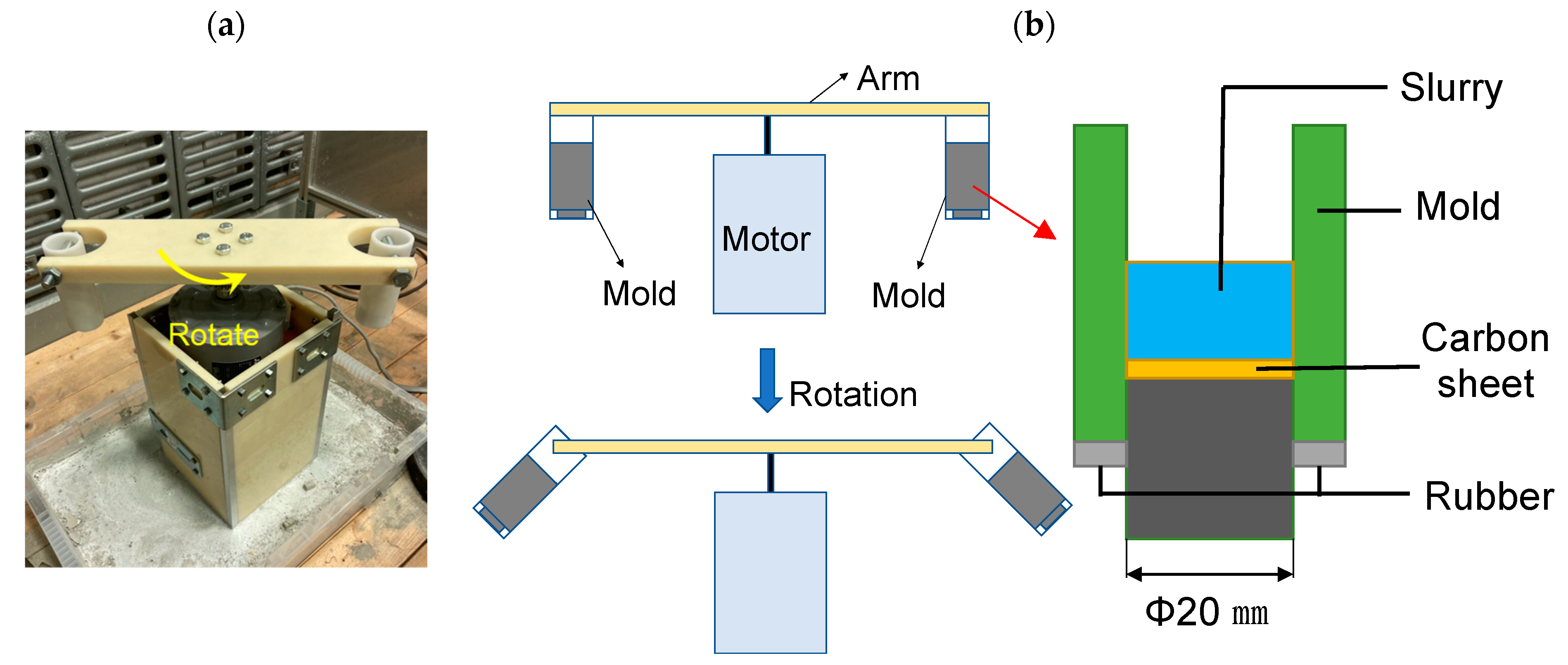

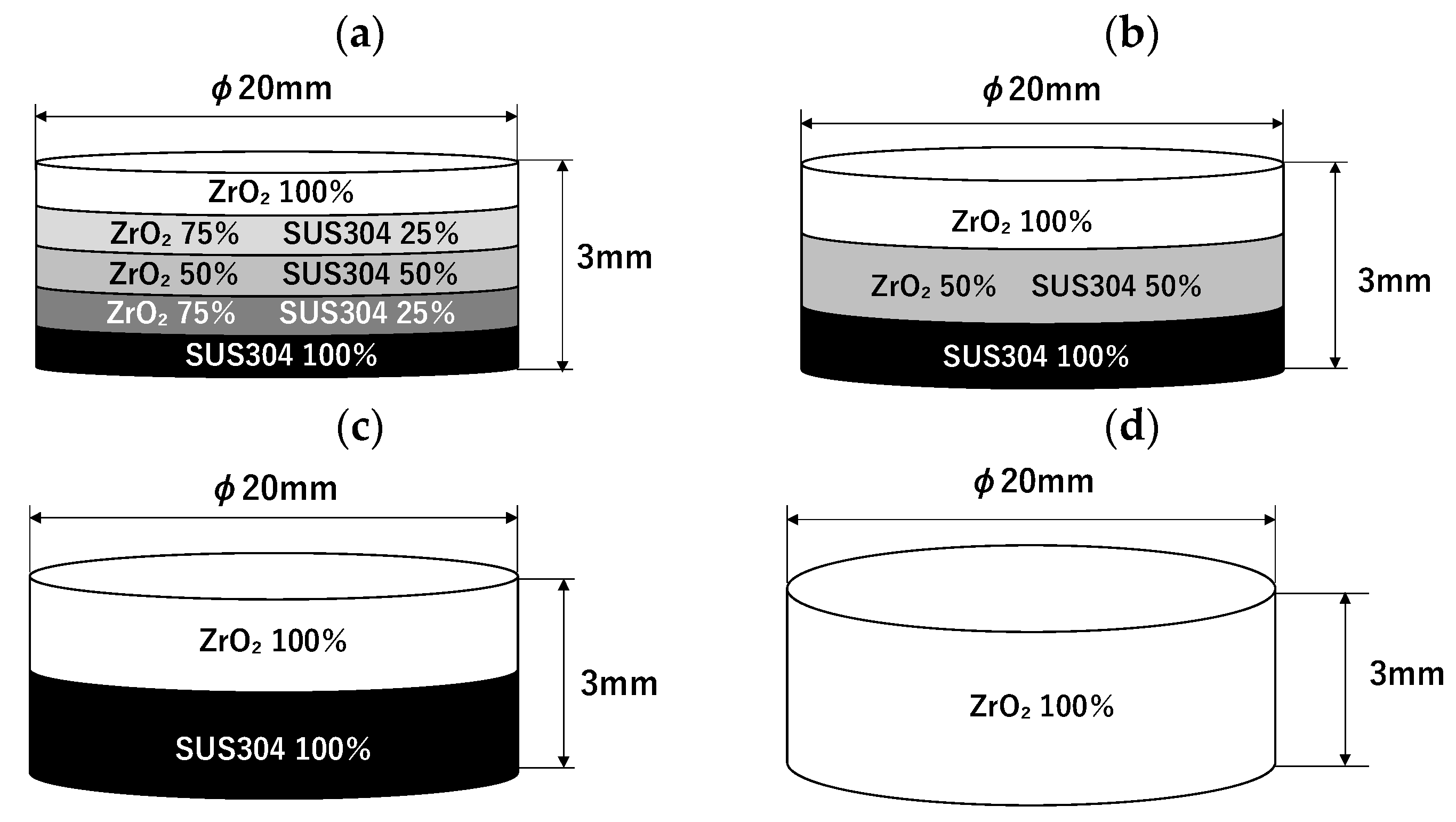
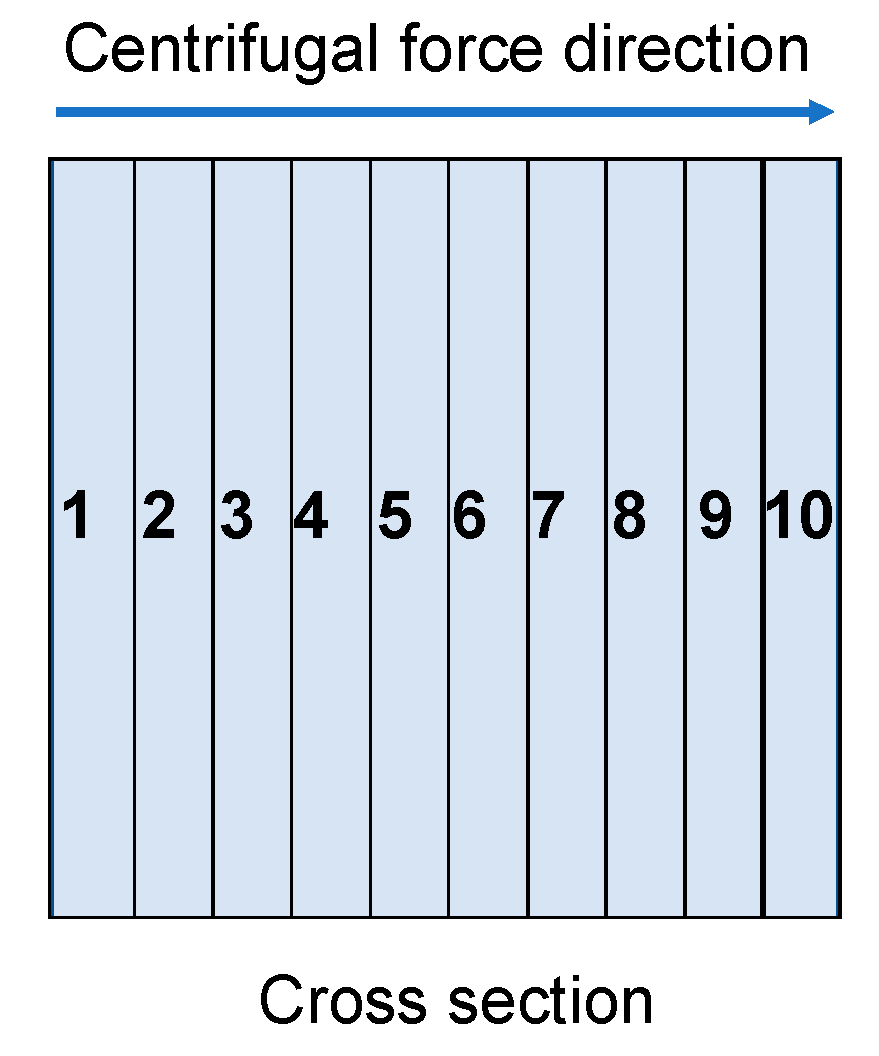
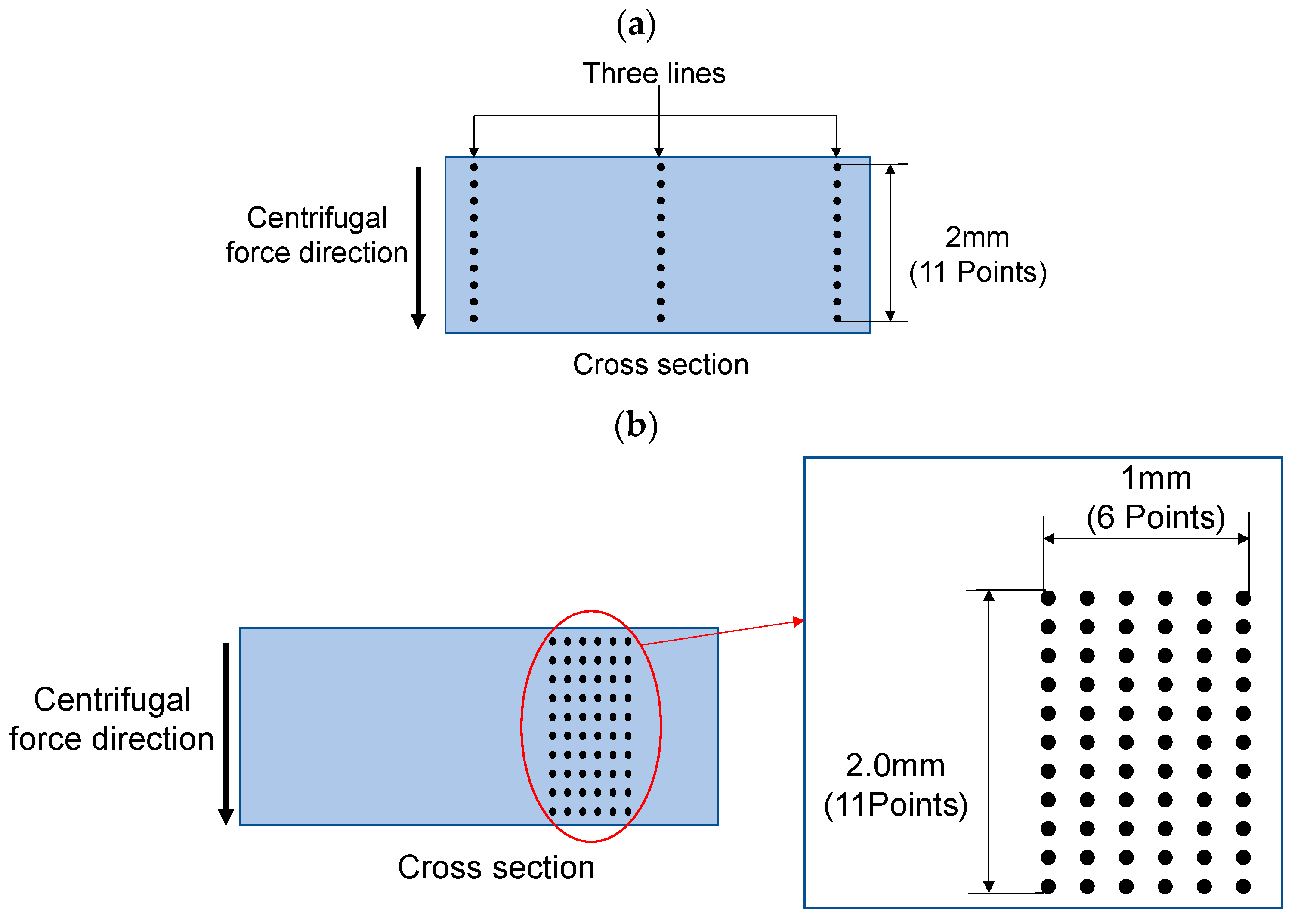
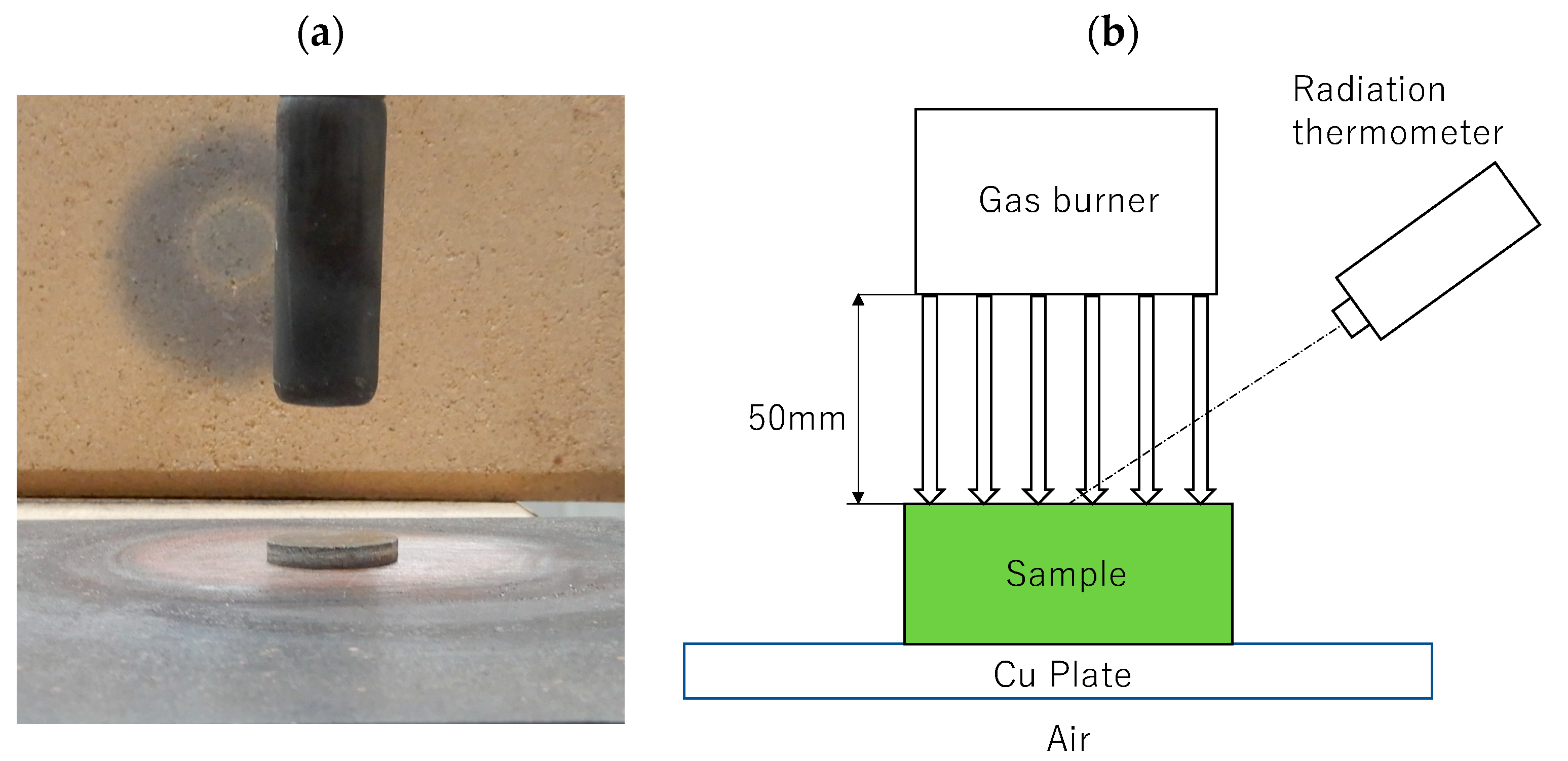
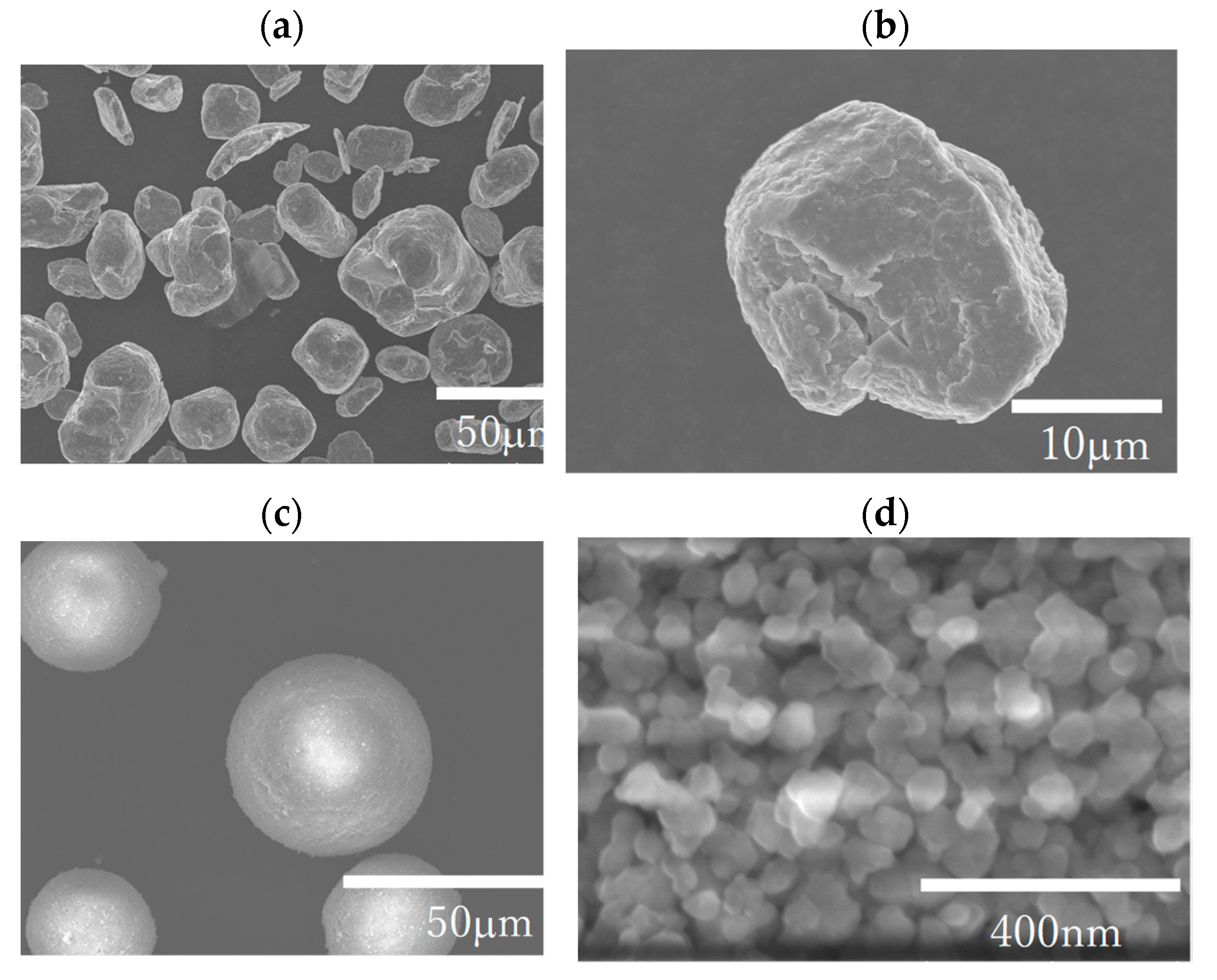


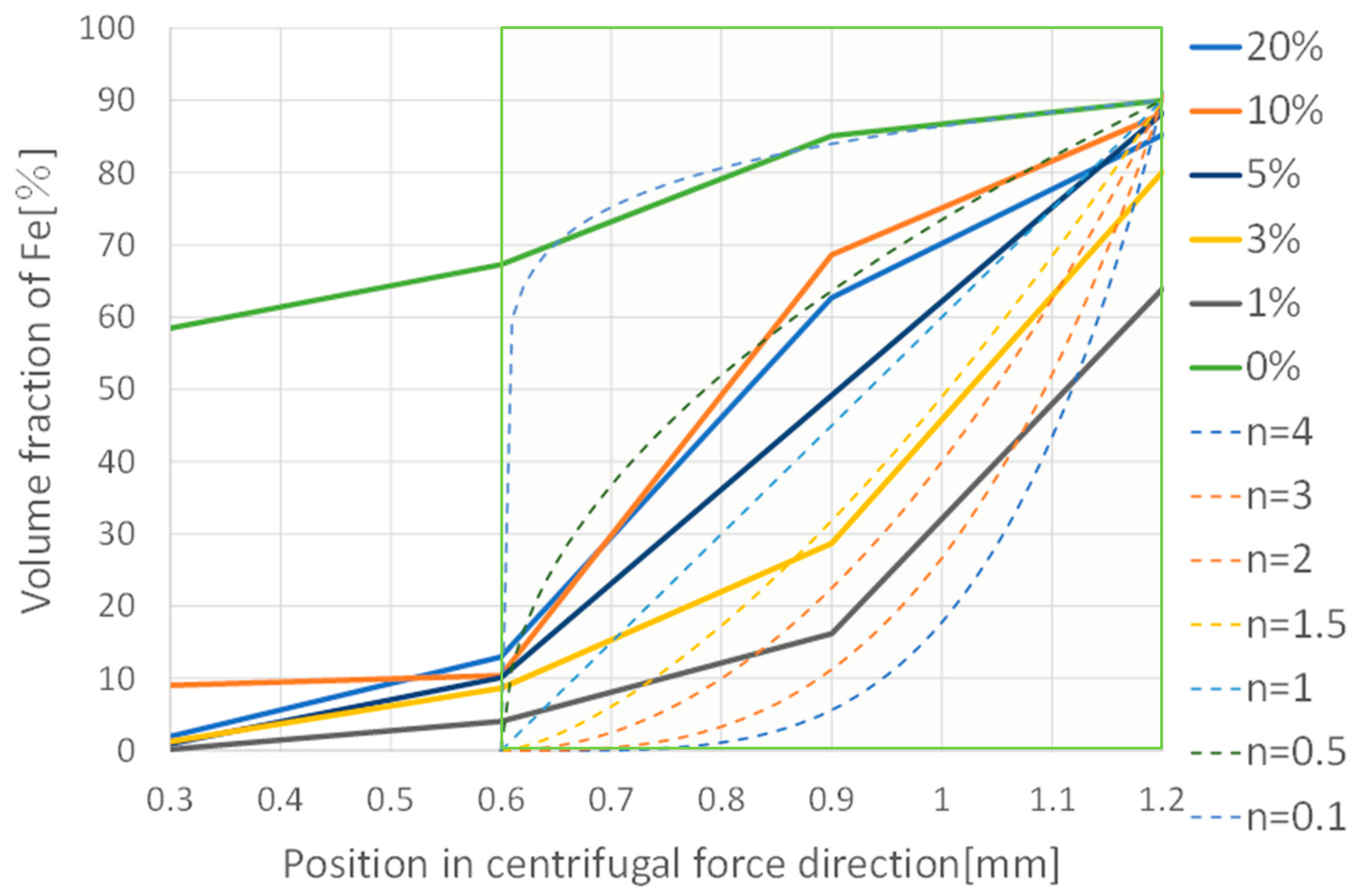



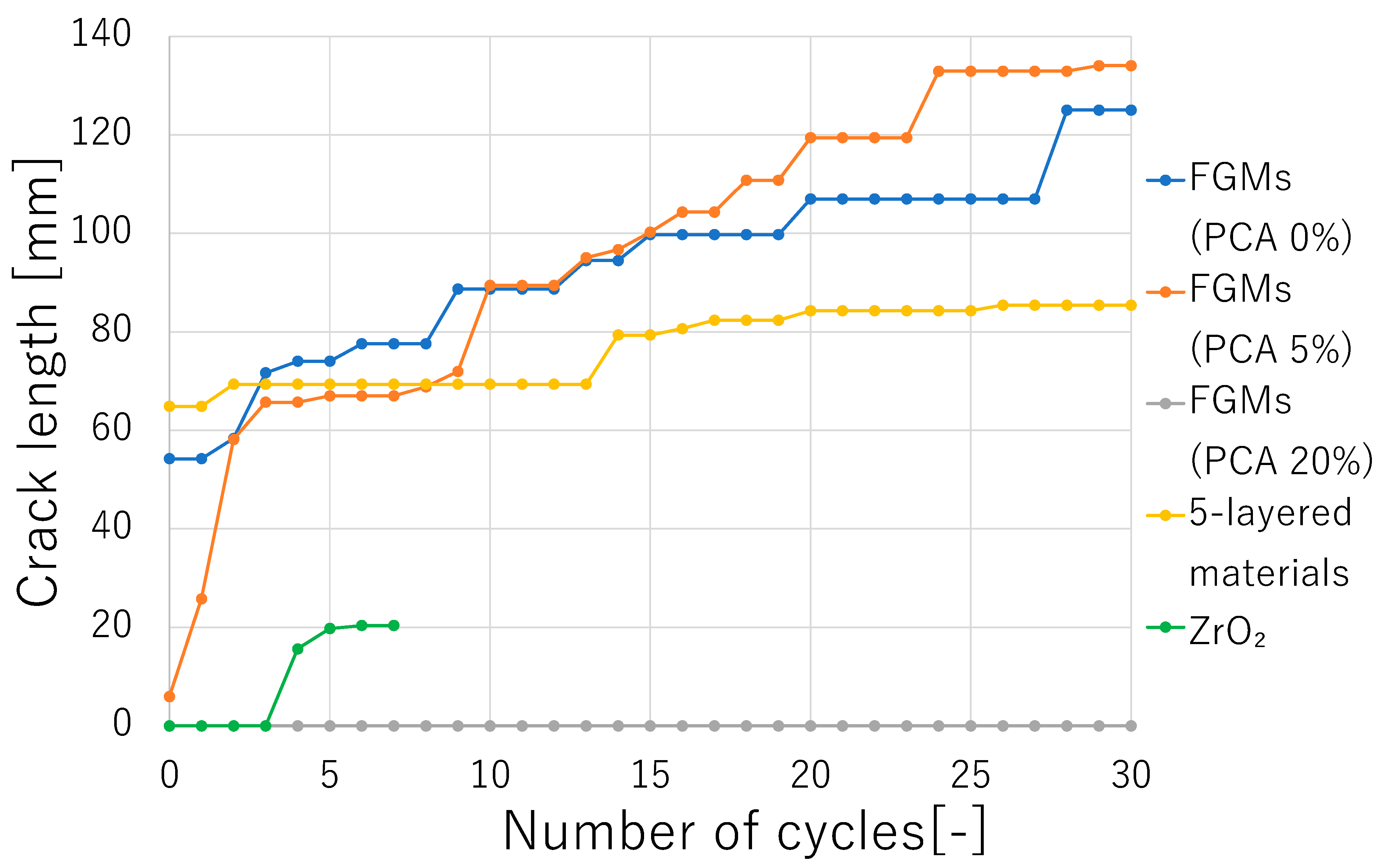


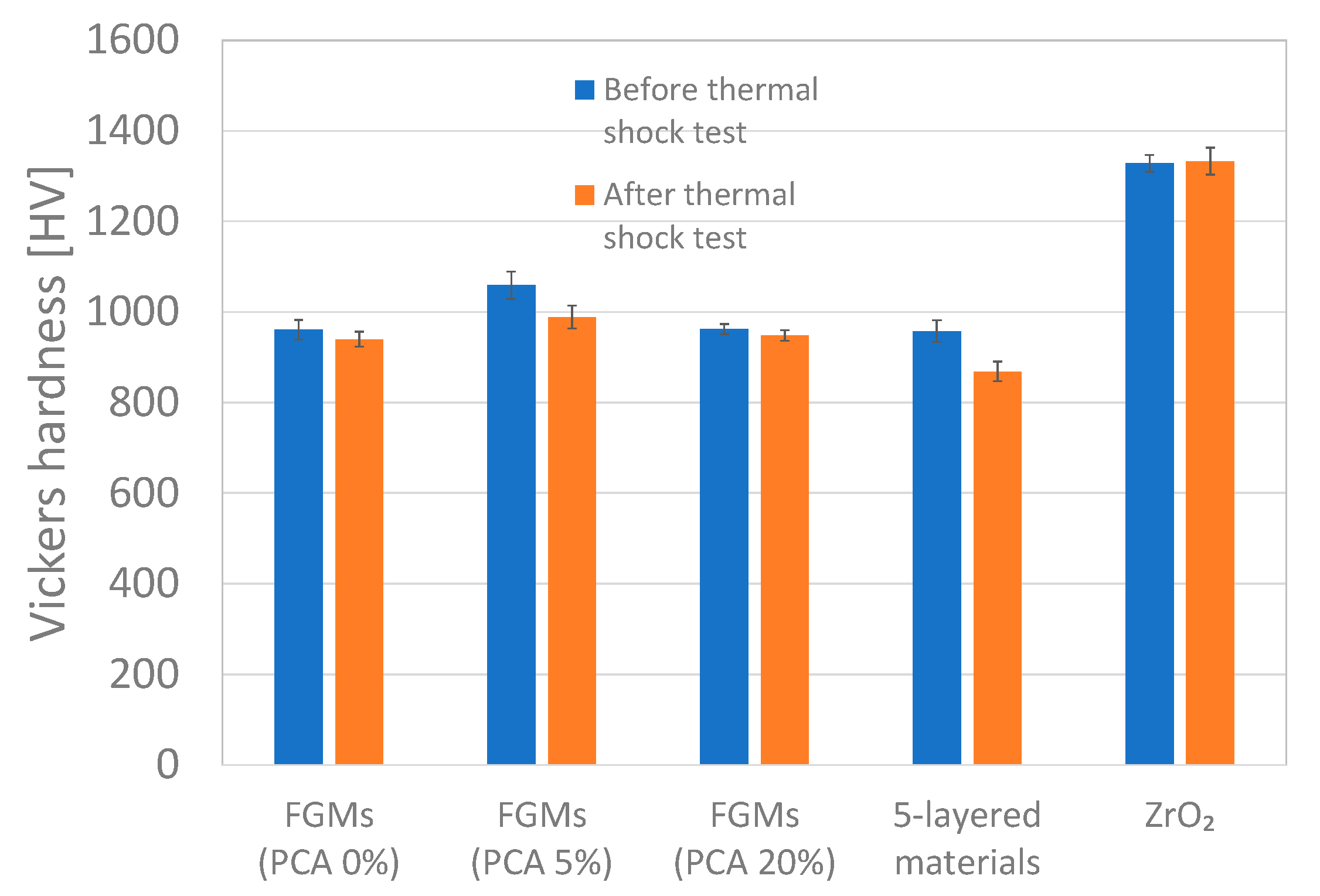

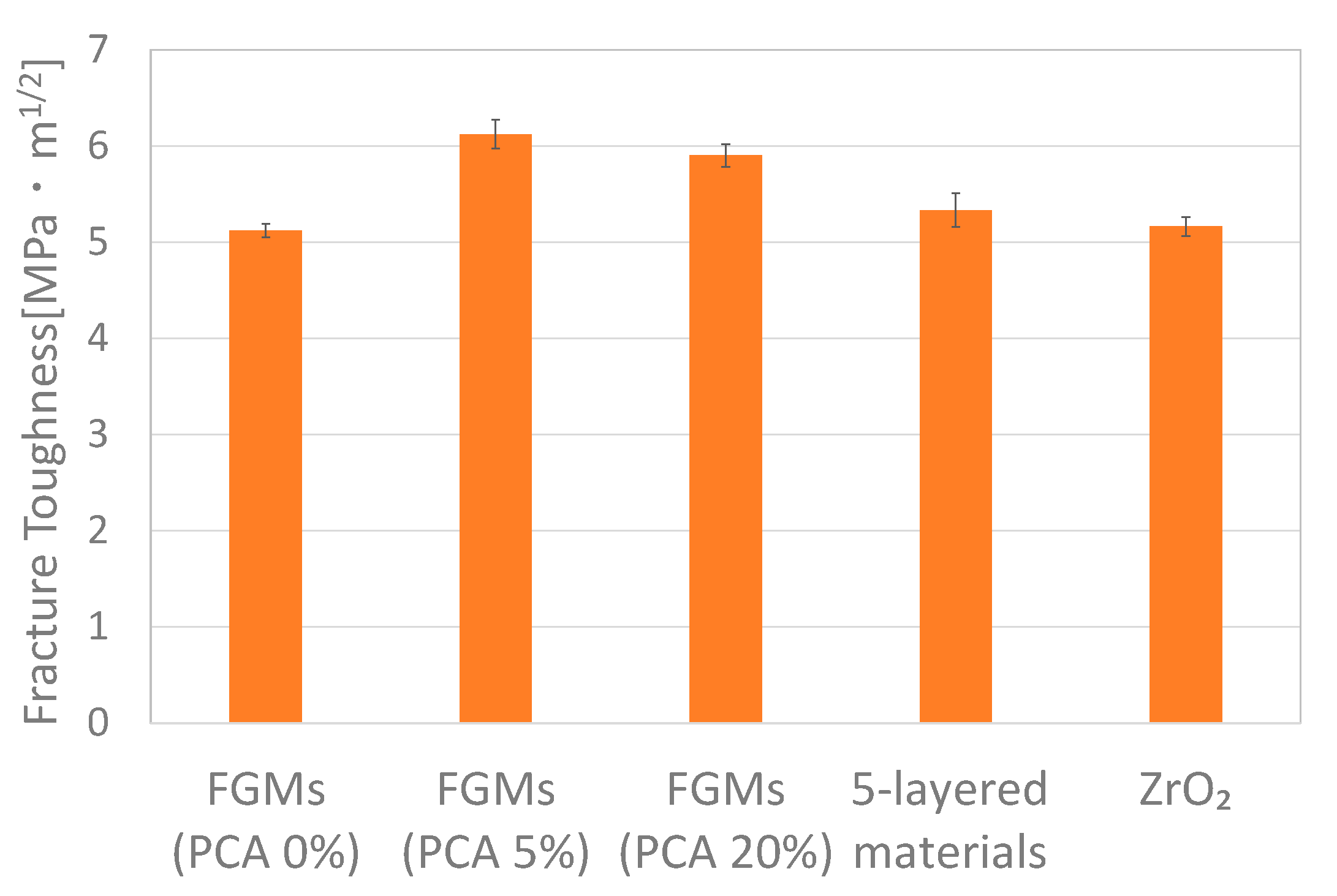

| Measuring Method | Load [mN] | Approaching Time [s] | Loading Time [s] | Unloading Time [s] |
|---|---|---|---|---|
| Micro Vickers hardness test | 4903 | 4 | 10 | 4 |
| Nanoindentation test | 30 | 30 | 10 | 30 |
| Density | Particle Size | |
|---|---|---|
| SUS304 | 7930 [kg/m3] | 40 [µm] |
| ZrO2 | 6050 [kg/m3] | 62 [nm] for a particle, 30 [µm] for an aggregation |
| Density | Viscosity | |
|---|---|---|
| Distilled water | 789 [kg/m3] | 0.89 [mPa·s] |
| PCA | 1084 [kg/m3] | 98 [mPa·s] |
Disclaimer/Publisher’s Note: The statements, opinions and data contained in all publications are solely those of the individual author(s) and contributor(s) and not of MDPI and/or the editor(s). MDPI and/or the editor(s) disclaim responsibility for any injury to people or property resulting from any ideas, methods, instructions or products referred to in the content. |
© 2023 by the author. Licensee MDPI, Basel, Switzerland. This article is an open access article distributed under the terms and conditions of the Creative Commons Attribution (CC BY) license (https://creativecommons.org/licenses/by/4.0/).
Share and Cite
Tsukamoto, H. Cyclic Thermal Shock Response of Zirconia/304 Stainless Steel Functionally Graded Materials Fabricated by Centrifugal Slurry Methods. J. Compos. Sci. 2023, 7, 69. https://doi.org/10.3390/jcs7020069
Tsukamoto H. Cyclic Thermal Shock Response of Zirconia/304 Stainless Steel Functionally Graded Materials Fabricated by Centrifugal Slurry Methods. Journal of Composites Science. 2023; 7(2):69. https://doi.org/10.3390/jcs7020069
Chicago/Turabian StyleTsukamoto, Hideaki. 2023. "Cyclic Thermal Shock Response of Zirconia/304 Stainless Steel Functionally Graded Materials Fabricated by Centrifugal Slurry Methods" Journal of Composites Science 7, no. 2: 69. https://doi.org/10.3390/jcs7020069





